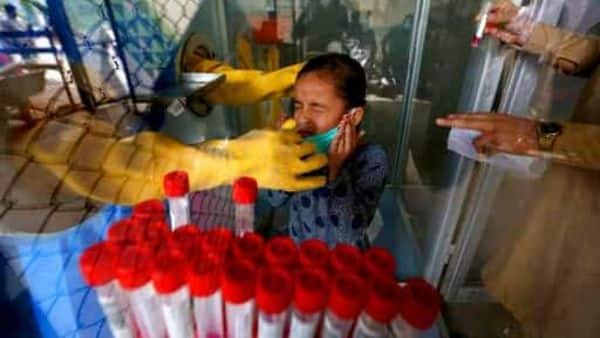In a worrying observation, an investigation by the Indian Council of Medical Research (ICMR) has found SARS CoV2 reinfection in 4.5% of SARS CoV-2 infected individuals studied.
The study titled ''SARS-CoV-2 re-infection: development of an epidemiological definition from India'' published by Cambridge in the Epidemiology and Infection journal, the investigation was conducted with the objective to develop an epidemiological case definition of possible SARS CoV-2 re-infection and assess its magnitude in India on over 1300 individuals.
"To conclude, a working epidemiological case definition of SARS CoV-2 re-infection is important to strengthen surveillance. The present investigation contributes to this goal and records reinfection in 4.5% of SARS CoV-2 infected individuals in India," the study stated. Taking available evidence into consideration, re-infection with SARS CoV-2 in the study was defined as any individual who tested positive for SARS-CoV-2 on two separate occasions by either molecular tests or rapid antigen test at an interval of at least 102 days with one negative molecular test in between.
“The findings may be a concern because the data was for only for 8 months 22nd January to 7th October 2020. This may be much higher or may be little lesser in the current scenario where we are seeing increasing fresh cases. That’s why it is very important to adopt protective behaviour even after infection or vaccination," said Dr Samiran Panda, head, epidemiology and communicable diseases, ICMR, one of the authors of the study. “The reinfection cases were earlier confirmed by only genome sequencing for which we need specific infrastructure which may not be available everywhere. With the new definition we can easily tab reinfection cases in India," he said.
The findings come at a time when the country is going through the second wave of infections, which is expected to be worse than the first one despite the ongoing vaccination, according to public health experts. While covid-19 re-infection is still rarely reported, nonetheless, immunity should not be assumed and public health measures such as physical distancing, hand-hygiene, and use of masks should be followed after recovery from first event of infection, the study stated.
While SARSCoV-2 re-infection is still a rare phenomenon, the researchers said, there is a need for epidemiological definition of re-infection for establishing surveillance systems. The findings may be a cause of concern for the government as under India’s countrywide vaccination drive the cumulative number of vaccines doses are nearing 70 million. The inoculation drive was rolled out on 16th Jan 2021 with vaccination of healthcare workers (HCWs) and vaccination of the frontline workers (FLWs) started from 2nd Feb 2021.The next phase of covid-19 vaccination commenced from 1st March 2021 for those who are over 60 years of age and for people aged 45 and above with specified co-morbid conditions.
Starting Thursday, the government also opened vaccination for all persons above 45 years of age irrespective of any comorbid condition. However, the Emergency Committee of the World Health Organization (WHO) Committee has been saying that the impact of vaccines in reducing transmission is yet to be known, the reinfection may pose hindrance in the country’s fight against the pandemic.
“There is lot of uncertainty around the immunity produced by a natural infection. No vaccine is 100% effective, only exception being small pox vaccine. The currently available vaccines are able to reduce laboratory confirmed symptomatic cases of Covid-19, and also cut down severe cases needing hospitalization and death. But asymptomatic infections are a possibility," said Lalit Kant, a scientist and former head of epidemiology and communicable diseases at ICMR.
“These vaccines were tested against the circulating strains of SARS CoV-2 when the clinical trials were done. With new variants now circulating in various parts of the world, chances of getting infection by another variant are there. Theoretically, re-infection after covid vaccination by same or a different variant is a possibility," he said.
Currently, there is no consensus regarding the working definition of re-infection, based only on epidemiological features; a resource intensive method like whole genome sequencing being the only confirmation. Centers for Disease Control and Prevention (CDC) has considered the duration of 90 days between two positive SARS-CoV-2 RNA along with genomic evidence of re-infection as an investigative criterion to understand the phenomenon of reinfection.
Both CDC and European CDC suggested the use of genomic evidence for confirmation of reinfection, However, an epidemiological working definition will be more pragmatic and helpful to assess the magnitude of re-infection in most population and resource constrained settings.
In this archive based, telephonic survey, 58 out of 1300 individuals (4.5%) fulfilled the ICMR’s suggestive definition; 38 individuals could be contacted with healthcare workers accounting for 31.6% of the cases. A large proportion of participants were asymptomatic and had higher Ct value during first episode. Ct refers to the number of cycles needed to amplify viral RNA to reach a detectable level. A high Ct value may be and indicator of viral load.
The authors further suggested that the samples of healthcare workers may be stored for genomic analysis to study suspected covid-19 reinfections, particularly in resource limited settings as chances of them encountering such events are higher due to potential high-risk occupational exposure.
Subscribe to Mint Newsletters





